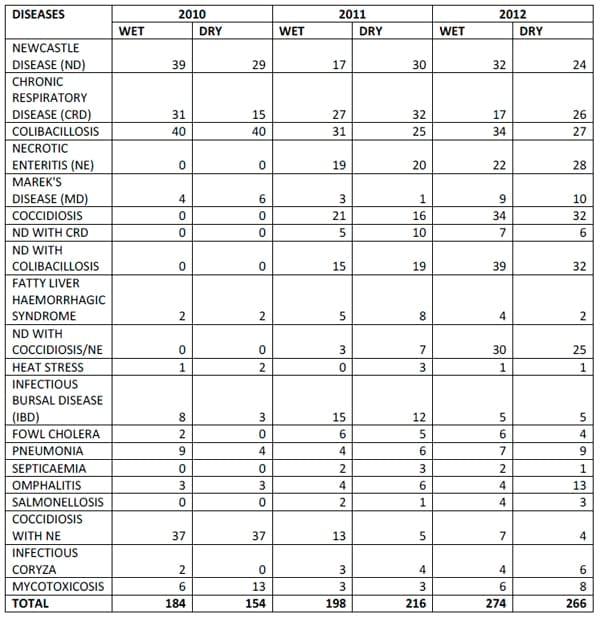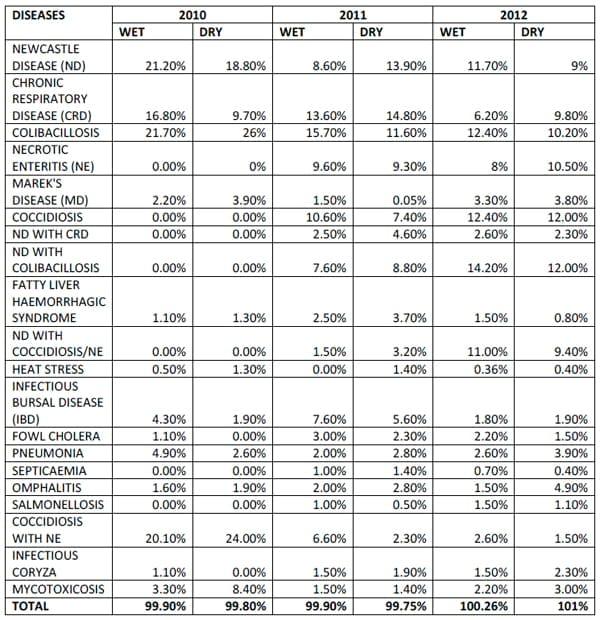Retrospective Survey of Common Diseases of Exotic Poultry Breeds in Lagos and Ogun States, Nigeria
Published: June 7, 2013
By: Dr. Sreenivasa Bharath M.S, Dr. Modupe O. Osuolale, Dr. Olayinka N. Ayanyemi,
Dr. Chigozie V. Obetta (Diversay Solutions Limited, Lagos, Nigeria)
Summary
A survey of diseases of poultry breeds was carried out in the South-Western Nigeria. The survey was conducted based on the carcasses presented to the pathology laboratory of Diversay Solutions Limited, Lagos, over a period of 3 years (2010-2012). Diagnosis of different disease conditions was made on the basis of the history, age of birds, clinical signs, gross and microscopic examination. The predominant diseases found during this survey are chronic respiratory disease, colibacillosis, Newcastle disease, coccidiosis and necrotic enteritis.
Introduction
The importance of Poultry industries in national economies of developing countries and its role in improving the nutritional status and income of many farmers and those with small land holdings as well as landless has been recognized by various scholars and rural development agencies in the last two decades [2–4].
Epidemiological analysis and interpretation permits, better decision-making on national disease control policies and priorities. In poultry more than any other type of livestock, environmental and management factors are inextricably linked with disease as determinants of productivity. Intensive poultry production is a highly competitive business with slim profit margins. A minor failure of health control, or excessive expenditure on drugs or vaccines, can easily turn the profit on a poultry enterprise into a loss. Therefore epidemiological analysis and disease control policy plays a key role in profitable forming [6].
Nigerian weather, like other West African countries, is divided into two overlapping seasons; wet and dry seasons. The wet or rainy season comes between April and October while the dry season comes between November and March. In the actual sense, the rainy season usually commences in the middle of March and extends to July before a brief dry season in August, called 'August break' which lasts for 2 to 3 weeks, and the rainy season continues till mid- October.
The objectives of this survey include:
- To access the prevalence of some poultry diseases, especially the endemic ones, in the country, particular in this region
- To identify any possible emerging poultry disease
- To determine seasonal trends in disease occurrence, if any, and ways of preventing them
- To generally educate poultry farmers and all other stakeholders in the poultry industry of the diseases that commonly afflict poultry in this geo-political zone, their symptoms and mode of treatment
Material and Methods
The survey was done by collating case records, of all walk-in customers of DSL veterinary laboratory in Lagos state, Nigeria, from 2010 to 2012. The laboratory has clients mostly from Lagos and Ogun states in Nigeria.
Disease diagnosis was based on the following: History taking, Gross pathology, Cytology, Wet mount, Bacterial isolation and identification [5].
- Bacteriological staining such as Gram's stain was used to differentiate Gram-positive from Gram-negative bacteria and Giemsa stain was used to determine the presence of bipolar bacteria in acute septicaemic infections and for cytology of organ impression smears
- Diagnosis of marek's disease was based on post mortem findings and cytology using Giemsa staining technique,
- While that of toxicosis is based on post mortem lesions and detection of high levels of toxins in feeds using ELISA test.
The frequency of each disease diagnosed in the laboratory was determined.
Since the seasons are overlapping, the year is divided into April-September (wet season) and November-March (dry season) for ease of interpretation.
Result and discussion
The results of the collected case records are tabulated in the tables 1-3 below. Table 1 shows the actual number of cases diagnosed per each disease within each year. Table 2 shows the disease occurrence in percentages for each year. Table 3 shows the incidence of the most commonly diagnosed diseases at the lab.
Table 1: Diseases diagnosed and their frequencies between 2010 and 2012

Table 2: Diseases occurrence pattern in % between 2010 and 2012

Wet = April- September
Dry = October-March
Dry = October-March
However, the above table does not completely represent all the diseases that were diagnosed at the laboratory since some diseases are diagnosed very rarely. Such diseases include gangrenous dermatitis, malabsorption syndrome, inclusion body hepatitis, calcium-phosphorous imbalance, fowlpox, hypovitaminosis, heat stress, gout, infectious bronchitis, helminthosis and non-specific tumors
The commonly diagnosed diseases in the lab are Newcastle disease, coccidiosis & necrotic enteritis, chronic respiratory disease, colibacillosis, marek's disease and infectious bursal disease. Though the heat stress cases were few, it can be attributed to the ease of diagnosis by field staff. Table 3 shows the occurrence in percentages of these diseases while figure 1 gives the graphical representation.
Table 3: Incidence of commonly diagnosed diseases at DSL between 2010 and 2012

*= The incidence here is the total sum of all the occurrence of this disease, either singly or in combination with other diseases.
Figure 1: Graphical representation of the commonly diagnosed diseases at DSL between 2010 and 2012.

Nevertheless, the result of the survey has shown that the most prevalent diseases are Newcastle disease and coccidiosis/necrotic enteritis, whose prevalence remains high throughout the year. Closely following these is colibacillosis, especially coliperitonitis, then chronic respiratory disease.
The following recommendations are made to combat diseases that are prevalent in this geopolitical zone for,
Newcastle disease:
- Use of potent vaccines from a good source; New batch of vaccine supplied to the farm should be tested for potency before use; Proper training of personnel who will handle vaccinations, both water-based and injectable; Regular seromonitoring for antibodies against Newcastle disease
Colibacillosis:
- To control the E.coli infection it is advised to go for sensitivity test and treat with the antibiotic of choice, rather than random selection of the antibiotics which often fail or make the infection relapse very fast, apart from inducing the drug resistance in bacteria. It is said that, any E.coli infection after chick stage is secondary, so the primary infection should be identified and treated, before treating E.coli infections. Use of good water source and use of water sanitizers to reduce the microbial load in the water to harmless levels
Necrotic enteritis (NE) with Coccidiosis:
- The incidence of NE with coccidiosis was high in birds kept on deep litter, especially during the raining season. This is usually due to the wetness of the litter .Many times, the disease complex is either misdiagnosed or treated randomly with some antibiotics making the losses huge. To combat NE with coccidiosis, the litter must be well-maintained. Wet litter must be promptly packed out and replaced with a fresh one. Cases of illness must be reported to a veterinarian so that the disease can be properly diagnosed and both coccidiosis and necrotic enteritis are treated on time.
CRD:
- If the case is presented early, it can be controlled more easily than when it is very chronic. House with least Dust and ammonia (eg: elevated pen house ) helps in preventing the CRD
Reference
1. F. C. Obiora, A Guide to Poultry Production in the Tropics, Acena Publishers, Enugu, Nigeria, 1st edition, 1992.
2. FAO (Food and Agricultural Organization of the United Nations), "Report on the expert consultation on rural poultry development in Asia, Dhaka, Bangladesh," Tech. Rep. 274415, FAO, Rome, Italy, March 1987.
3. L. E. Creevey, "Supporting small-scale enterprises for women farmers in the Sahel," Journal of International Development, vol. 3, no. 4, pp. 355–386, 1991. View at Scopus
4. A. J. Kitalyi, "Village chicken Production Systems in Rural Africa. Household Food Security and Gender Issues," Animal Production and Health Paper, Food and Agriculture Organisation of the United Nation, Rome, Italy, 1998.
5. M. R. Islam, B. C. Das, K. Hossain, N. S. Lucky and M. G. Mostafa A Study on the Occurrence of Poultry Diseases in Sylhet Region of Bangladesh Medicine and Surgery Department, Sylhet Government Veterinary College, Field Diseases Investigation Laboratory, Tilagor, Sylhet-3100, Bangladesh
6. A. James, EPIDEMIOLOGICAL ANALYSIS AND INTERPRETATION OF SERIOUS POULTRY DISEASES.Veterinary Epidemiology and Economics Research Unit, University of Reading, Department of Agriculture. FAO/OIE/WHO (1997). Animal health yearbook 1995. Food and Agriculture Organization of the United Nations.Rome.
Related topics:
Authors:
Recommend
Comment
Share

Would you like to discuss another topic? Create a new post to engage with experts in the community.








.jpg&w=3840&q=75)